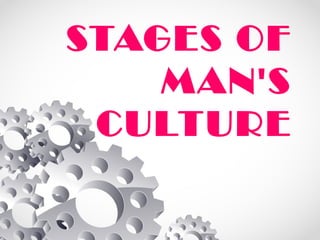
Stages of man
- 2. Archeologists divided the Stone Age 1. Old Stone Age or Paleolithic (2million BCE-8000BCE) 2. Middle Stone Age or Mesolithic Age(11,000-6,000BC) 3. New Stone Age or Neolithic Age (6,800-3,2000BC)
- 3. Old Stone Age or Paleolithic Age The term was coined by John Lubbock in 1865 Greek word palaios which means "old" and lithos which means "stone" People at this age who inhabited the continents of Europe, Asia, and Africa
- 6. They lived by hunting and fishing Skill with fire and stone tools They have vague religious ideas such as offering sacrifices, food, and ornaments to the dead
- 7. Experts think this came about when people began to hunt large animals They needed to be able to give out clear instructions They also learned how to make fire Early people used fire to keepEarly people used fire to keep themthem warmwarm
- 8. Middle Stone Age or Mesolithic period Involves the gradual domestication of plants and animals and the formation of settled communities Dogs became valuable for hunting and guarding property, they were probably the first animal to be domesticated
- 10. Early people developed a language, before they learned to talk, early people simply made sounds Hand signals were also meaningful Gradually people developed languages
- 11. New Stone Age or Neolithic Period The term neolithic was derived from greek word neolithikos where neos means new and litos means stone invented by John Lubbock in 1865 Two important discoveries changed people from being good gatherers to food producers
- 12. First was learning to grow food Second learning to herd animals They also learned to use animals in dragging their primitive plow in transporting their belongings
- 15. "The lovers of Valdaro" Believed to be from the Neolithic period. Excavated in a single block, so as not to separate them from each other. Named for the little village near Mantua, in Northern Italy.
- 16. Another step in man's advancement was the building of permanent homes Earliest known villages in the world were found in Middle East one of these is in Jericho in Israel Another village was in Catal Huyuk in present-day Turkey
- 17. The Age of Metals Egyptians first to used copper as early as 5, 000 BCE At about 2000 BCE, man discovered that mixture of copper and tin produced harder metal bronze With this discovery, man created stronger and better tools, weapons, and utensils
- 18. COPPER
- 19. BRONZE
- 20. IRON
- 21. Iron age started about 1,000 BCE it is more stronger and durable compare to copper or bronze As a result of this discovery , civilization leaped and bounced. Transportation methods were improved when iron made the building of sturdier and faster vehicles possible
- 22. Civilization rose in the valleys of the Nile River in Egypt The Indus River in India Yellow or Huang Ho River in China
- 23. Nile River in Egypt
- 24. Indus River in India
- 25. Yellow or Huang Ho River in China
- 26. Emergence of Civilization Five characteristics of civilization 1. Advanced cities 2. Specialized workers 3. Complex institutions 4. Record keeping 5. Advanced technology
- 27. Advanced Cities Advanced cities were birthplaces of civilizations.The word "civilization" came from latin word civitas which means "city" A city is more than a large of people living togeher, it is the center of trade for large area.
- 28. Specialized Workers Such as traders, government officials, and priests Specialization is the enhancement of skills for a specific kind of work Social organization in cities became complex, people ranked according to their jobs.
- 29. Complex Institutions The growing populations of early cities made a system of government necessary In civilization leaders emerged to maintain order among people and to establish laws
- 30. The priests usually occupy the top level in the society Below them are the few merchants Followed by the artisans Those below are the majority of the people Slaves are on te lowest level.
- 31. Record Keeping Was equally important as government officials had to document tax collections, the passage of laws, and the storage of grains and other products
